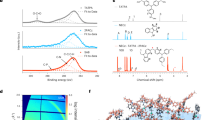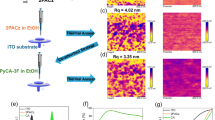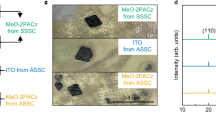Abstract
Hole-selective self-assembled monolayers (SAMs)1,2 have played a key role in driving the certified power conversion efficiency (PCE) of inverted perovskite solar cells3,4,5 to 26.7% (ref. 6). However, their instability often compromises the operational performance of devices, strongly hindering their practical applications7,8. Here we employ a cross-linkable co-SAM to enhance the conformational stability of hole-selective SAMs against external stresses, while suppressing the formation of defects and voids in SAM during self-assembly. The azide-containing SAM can be thermally activated to form a cross-linked and densely assembled co-SAM with a thermally stable conformation and preferred orientation. This effectively minimizes substrate surface exposure caused by wiggling of loose SAMs under thermal stress, preventing perovskite decomposition. This enables a certified PCE of 26.92% to be achieved for the best-performing cell, which also possesses excellent thermal stability with negligible decay under maximum-power-point tracking at 85 °C for 1,000 h. It also retains >98% of initial PCE after 700 repetitive thermal cycles between −40 °C and 85 °C, representing the state of the art of the field. This work offers an in-depth understanding of SAM degradation mechanisms to guide the design of a more robust buried interface for SAM-based devices adopting high-roughness substrates to realize highly efficient and durable perovskite solar cells.
This is a preview of subscription content, access via your institution
Access options
Access Nature and 54 other Nature Portfolio journals
Get Nature+, our best-value online-access subscription
$32.99 / 30 days
cancel any time
Subscribe to this journal
Receive 51 print issues and online access
$199.00 per year
only $3.90 per issue
Buy this article
- Purchase on SpringerLink
- Instant access to full article PDF
Prices may be subject to local taxes which are calculated during checkout




Similar content being viewed by others
Data availability
All data generated or analysed during this study are included in the published article and its Supplementary Information.
References
Li, M. et al. Self-assembled monolayers for interfacial engineering in solution-processed thin-film electronic devices: design, fabrication, and applications. Chem. Rev. 124, 2138–2204 (2024).
Isikgor, F. H. et al. Molecular engineering of contact interfaces for high-performance perovskite solar cells. Nat. Rev. Mater. 8, 89–108 (2023).
Wu, X. et al. Designs from single junctions, heterojunctions to multijunctions for high-performance perovskite solar cells. Chem. Soc. Rev. 50, 13090–13128 (2021).
Jiang, Q. et al. Towards linking lab and field lifetimes of perovskite solar cells. Nature 623, 313–318 (2023).
Jiang, Q. & Zhu, K. Rapid advances enabling high-performance inverted perovskite solar cells. Nat. Rev. Mater. 9, 399–419 (2024).
Best Research-Cell Efficiency Chart (National Renewable Energy Laboratory, 2025); www.nrel.gov/pv/cell-efficiency.html.
Zhang, S. et al. Conjugated self-assembled monolayer as stable hole-selective contact for inverted perovskite solar cells. ACS Mater. Lett. 4, 1976–1983 (2022).
Zhao, K. et al. peri-Fused polyaromatic molecular contacts for perovskite solar cells. Nature 632, 301–306 (2024).
Zhang, X. et al. Advances in inverted perovskite solar cells. Nat. Photon. 18, 1243–1253 (2024).
Chen, H. et al. Improved charge extraction in inverted perovskite solar cells with dual-site-binding ligands. Science 384, 189–193 (2024).
Magomedov, A. et al. Self-assembled hole transporting monolayer for highly efficient perovskite solar cells. Adv. Energy Mater. 8, 1801892 (2018).
Al-Ashouri, A. et al. Conformal monolayer contacts with lossless interfaces for perovskite single junction and monolithic tandem solar cells. Energy Environ. Sci. 12, 3356–3369 (2019).
Al-Ashouri, A. et al. Monolithic perovskite/silicon tandem solar cell with >29% efficiency by enhanced hole extraction. Science 370, 1300–1309 (2020).
Tan, Q. et al. Inverted perovskite solar cells using dimethylacridine-based dopants. Nature 620, 545–551 (2023).
Zhang, S. et al. Minimizing buried interfacial defects for efficient inverted perovskite solar cells. Science 380, 404–409 (2023).
Liu, S. et al. Buried interface molecular hybrid for inverted perovskite solar cells. Nature 632, 536–542 (2024).
Tang, H. et al. Reinforcing self-assembly of hole transport molecules for stable inverted perovskite solar cells. Science 383, 1236–1240 (2024).
Yu, S. et al. Homogenized NiOx nanoparticles for improved hole transport in inverted perovskite solar cells. Science 382, 1399–1404 (2023).
Peng, W. et al. Reducing nonradiative recombination in perovskite solar cells with a porous insulator contact. Science 379, 683–690 (2023).
Liu, M. et al. Compact hole-selective self-assembled monolayers enabled by disassembling micelles in solution for efficient perovskite solar cells. Adv. Mater. 35, 2304415 (2023).
Jiang, W. et al. Spin-coated and vacuum-processed hole-extracting self-assembled multilayers with H-aggregation for high-performance inverted perovskite solar cells. Angew. Chem. Int. Ed. 63, e202411730 (2024).
Jiang, W. et al. π‐Expanded carbazoles as hole‐selective self‐assembled monolayers for high‐performance perovskite solar cells. Angew. Chem. Int. Ed. 61, e202213560 (2022).
Kolb, H. C. et al. Click chemistry: diverse chemical function from a few good reactions. Angew. Chem. Int. Ed. 40, 2004–2021 (2001).
Freudenberg, J. et al. Immobilization strategies for organic semiconducting conjugated polymers. Chem. Rev. 118, 5598–5689 (2018).
Lenz, T. et al. Self-assembled monolayer exchange reactions as a tool for channel interface engineering in low-voltage organic thin-film transistors. Langmuir 28, 13900–13904 (2012).
Gao, C. et al. A dual functional diketopyrrolopyrrole-based conjugated polymer as single component semiconducting photoresist by appending azide groups in the side chains. Adv. Sci. 9, e2106087 (2022).
Jiang, W. et al. Fluoro-substituted DPP-bisthiophene conjugated polymer with azides in the side chains as ambipolar semiconductor and photoresist. Sci. China Chem. 65, 1791–1797 (2022).
Deng, X. et al. Co-assembled monolayers as hole-selective contact for high-performance inverted perovskite solar cells with optimized recombination loss and long-term stability. Angew. Chem. Int. Ed. 61, e202203088 (2022).
Park, S. M. et al. Low-loss contacts on textured substrates for inverted perovskite solar cells. Nature 624, 289–294 (2023).
Zorn, G. et al. X-Ray photoelectron spectroscopy investigation of the nitrogen species in photoactive perfluorophenylazide-modified surfaces. J. Phys. Chem. C 118, 376–383 (2014).
Qu, G. et al. Reformation of thiophene-functionalized phthalocyanine isomers for defect passivation to achieve stable and efficient perovskite solar cells. J. Energy Chem. 67, 263–275 (2022).
Almora, O. et al. On Mott–Schottky analysis interpretation of capacitance measurements in organometal perovskite solar cells. Appl. Phy. Lett. 109, 173903 (2016).
Jang, Y.-W. et al. Intact 2D/3D halide junction perovskite solar cells via solid-phase in-plane growth. Nat. Energy 6, 63–71 (2021).
Li, X. et al. Constructing heterojunctions by surface sulfidation for efficient inverted perovskite solar cells. Science 375, 434–437 (2022).
Rau, U. & Kirchartz, T. Charge carrier collection and contact selectivity in solar cells. Adv. Mater. Interfaces 6, 1900252 (2019).
Wetzelaer, G. J. et al. Trap-assisted non-radiative recombination in organic-inorganic perovskite solar cells. Adv. Mater. 27, 1837–1841 (2015).
Jiang, W. et al. Rational molecular design of multifunctional self-assembled monolayers for efficient hole selection and buried interface passivation in inverted perovskite solar cells. Chem. Sci. 15, 2778–2785 (2024).
Zhan, C. et al. Indium tin oxide induced internal positive feedback and indium ion transport in perovskite solar cells. Angew. Chem. Int. Ed. 63, e202403824 (2024).
Zhou, Y. et al. Advances and challenges in understanding the microscopic structure–property–performance relationship in perovskite solar cells. Nat. Energy 7, 794–807 (2022).
Kerner, R. A. & Rand, B. P. Electrochemical and thermal etching of indium tin oxide by solid-state hybrid organic–inorganic perovskites. ACS Appl. Energy Mater. 2, 6097–6101 (2019).
Roose, B. et al. Critical assessment of the use of excess lead iodide in lead halide perovskite solar cells. J. Phys. Chem. Lett. 11, 6505–6512 (2020).
Shi, L. et al. Gas chromatography-mass spectrometry analyses of encapsulated stable perovskite solar cells. Science 368, eaba2412 (2020).
Penkov, O. V. et al. I. X-Ray Calc 3: improved software for simulation and inverse problem solving for X-ray reflectivity. J. Appl Crystallogr. 57, 555–566 (2024).
Acknowledgements
We thank M.Q.C. from City University of Hong Kong and Z.X.X. from the South University of Science and Technology for their support with long-term device stability tests. A.K.-Y.J. acknowledges sponsorship from the Lee Shau-Kee Chair Professor (Materials Science), and support from APRC grants of the City University of Hong Kong (grant nos. 9380086, 9610419, 9610440, 9610492 and 9610508), the TCFS (grant no. GHP/018/20SZ), MHKJFS (grant no. MHP/054/23) and MRP (grant no. MRP/040/21X) grants from the Innovation and Technology Commission of Hong Kong, the Green Tech Fund from the Environment and Ecology Bureau of Hong Kong (grant no. 202020164), and GRF (grant nos. 11304424, 11307621, 11316422 and 11308625) and CRS grants (CRS_CityU104/23, CRS_HKUST203/23) from the Research Grants Council of Hong Kong. This work was partially financially supported by the City University of Hong Kong (grant no. 9610739) via the ‘Fostering Innovation for Resilience and Sustainable Transformation’ project, which is officially endorsed by the United Nations Educational, Scientific and Cultural Organization under the International Decade of Sciences for Sustainable Development (2024–2033). J.Z. is grateful for sponsorship from the National Natural Science Foundation of China (grant no. 52002393). S.F.W. is grateful for the support from Start-up Fund (Lingnan University, Hong Kong). T.W. and Q.J. are grateful to the National Key R&D Program of China (grant no. 2023YFB3003001) and the National Natural Science Foundation of China (grant no. 52130101) for their support. We acknowledge Towngas Energy Chuangke (Shenzhen) for their assistance with device certification.
Author information
Authors and Affiliations
Contributions
W.J., S.W. and A.J. conceived the original idea. W.J. refined the experimental protocol, and designed and synthesized JJ24 under the supervision of A.J. The perovskite films and devices were fabricated by G.Q., S.W. and J.Z. Data analysis was performed by W.J. and G.Q. under the guidance of S.W., J.Z. and A.J. Theoretical calculations were performed by L.C. and T.W. under the supervision of Q.J., X.H. and X.C., and C-T.W. assisted with characterization and device fabrication. F.R.L. and C.Y. provided helpful discussions. W.J. wrote the paper, which was revised by G.Q., S.W., J.Z. and A.J. All authors discussed the results and commented on the paper. A.J. supervised the project.
Corresponding authors
Ethics declarations
Competing interests
The authors declare no competing interests.
Peer review
Peer review information
Nature thanks the anonymous reviewers for their contribution to the peer review of this work.
Additional information
Publisher’s note Springer Nature remains neutral with regard to jurisdictional claims in published maps and institutional affiliations.
Extended data figures and tables
Extended Data Fig. 1 J-V curves of other p-type SAMs toughened with JJ24.
J-V characteristics of the champion PSCs based on 4PACz, CbzPh and CbzBT with and without JJ24 cross-linking.
Extended Data Fig. 2 Long-term operational stability of devices based other p-type SAMs toughened with JJ24.
Long-term operational stability of the encapsulated PSCs based on different p-type SAM molecules at MPP tracking under continuous 1-sun equivalent illumination at 85 °C in ambient air with RH of 70–80%, complied with the ISOS-L-2 protocol.
Extended Data Fig. 3 Cross-sectional SEM images of perovskite films.
Cross-sectional SEM images of control and target perovskite films before and after ageing (under continuous illumination at 85 °C for 100 h).
Extended Data Fig. 4 XRD patterns of perovskite films.
XRD patterns of control and target perovskite films before and after ageing (under continuous illumination at 85 °C for 100 h).
Supplementary information
Supplementary Information
Supplementary Notes 1 and 2, Figs. 1–39, Tables 1–4 and references.
Rights and permissions
Springer Nature or its licensor (e.g. a society or other partner) holds exclusive rights to this article under a publishing agreement with the author(s) or other rightsholder(s); author self-archiving of the accepted manuscript version of this article is solely governed by the terms of such publishing agreement and applicable law.
About this article
Cite this article
Jiang, W., Qu, G., Huang, X. et al. Toughened self-assembled monolayers for durable perovskite solar cells. Nature 646, 95–101 (2025). https://doi.org/10.1038/s41586-025-09509-7
Received:
Accepted:
Published:
Issue date:
DOI: https://doi.org/10.1038/s41586-025-09509-7



